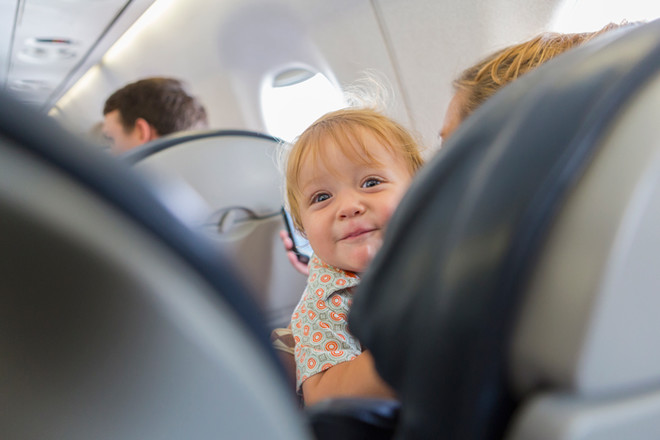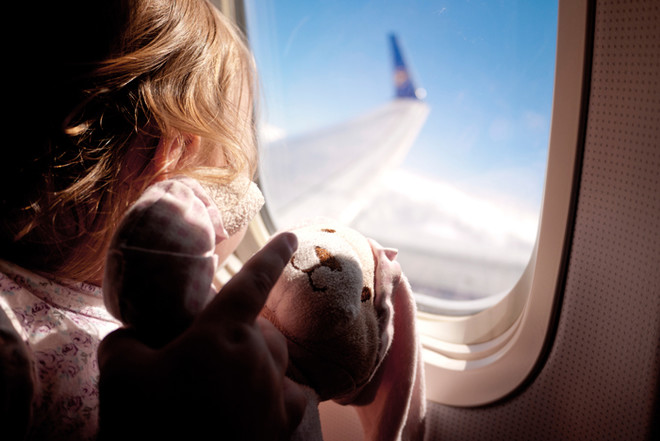 A photo: Thinkstock / GettyimagesJulia Minchin, the founder of the online store for baby and toddler products, asked more than 600 parents to determine their biggest worries about traveling with young children. 32% of respondents answered that they do not even allow thought about such trips. The fourth part of all traveling parents answered that it was a sad experience. Many admitted that they are afraid of how the child will perceive the restriction in the form of a safety belt. How to make traveling on the plane comfortable and safe for you and your baby?
A photo: Thinkstock / GettyimagesJulia Minchin, the founder of the online store for baby and toddler products, asked more than 600 parents to determine their biggest worries about traveling with young children. 32% of respondents answered that they do not even allow thought about such trips. The fourth part of all traveling parents answered that it was a sad experience. Many admitted that they are afraid of how the child will perceive the restriction in the form of a safety belt. How to make traveling on the plane comfortable and safe for you and your baby?
1. Think carefully about the schedule
It's a very good idea to plan.Traveling with your baby's schedule in mind. Child care specialist Kristen Harding says that this is the key to a comfortable flight. You know your baby better than anyone. During the day, he has periods of activity, and then there are moments of peace. If you plan your flight for a time when your baby doesn't like to play much, or even better - during his nap, then the few hours spent on the plane can go quite smoothly and without unnecessary incidents. Photo: Thinkstock / Gettyimages
Photo: Thinkstock / Gettyimages
2. Correctly pack things
We have all faced the problem:how to fit all the things we consider necessary into suitcases. It's the same with baby things. Decide in advance which things need to be checked in and which ones should be left as carry-on luggage. You can't do without diapers, a bottle of food (plastic only), and wet wipes on the road. Mothers are also allowed to take a carrycot on the plane, which must be ordered from the airline at least a day before departure. There are no such carrycots on board the plane. Many parents consider airline requirements for carry-on luggage too strict and complicated. For example, many problems arise with baby strollers. Some airlines allow you to take the stroller to the gangway, some do not. Depending on the conditions, you either hand it over to the flight attendants when entering the plane or immediately in your baggage. Be sure to clarify all the details about handing over and receiving the stroller in advance, especially if you are flying on a transit flight. Photo: Thinkstock / Gettyimages
Photo: Thinkstock / Gettyimages
3. Stock up with sweets and marmalade
Problems with ear congestion during takeoff andlandings occur because the pressure in the cabin changes quickly and a difference in pressure between the external environment and the human body is formed. Even adults constantly experience discomfort due to pressure in the ears during takeoff and landing, not to mention babies. If your baby is still feeding from a bottle or is breastfed, this is the best time to feed him. Dr. Margot Sunderland, Director of the Department of Education and Training at the Center for Children's Mental Health, author of the bestseller "The Science of Parenting", advises to start a game of yawning with your child on the plane; after all, the process of yawning is considered "contagious" and the baby will repeat after you. This will help him cope with ear congestion. Useful actions that will help cope with discomfort in the ears include swallowing, sucking and yawning. Make sure you take enough sweets or chewing gum with you.
4. Use distraction tactics
Adults hate boredom, but children hate everythingmuch worse. If they are bored, it causes high levels of stress hormones in the brain and body, causing them to cry or get angry. This behavior leads to hyperarousal. Remember the power of games and toys. Consider the time you will be on the plane and the time your child will be playing. Have a bag of surprises ready, which should contain both old favorites and a few new ones. Do not give them to your child all at once, but gradually, one by one, as interest wanes. Take a few finger puppets with you and entertain your baby with them at the first sign of irritation or excitement. Such play devices cause an increase in opioids and oxytocin in the brain (natural calming and anti-aggressive chemicals). For young children, it is good to take coloring books or sensory toys with you so that they do not have the desire to get up from their seat and jump around the cabin. Photo: Thinkstock / Gettyimages
Photo: Thinkstock / Gettyimages
5. Stay calm
Of course, it's easier said than done, but it isvery important. It takes children and babies milliseconds to react to the emotional state of their parents, picking up on their facial expressions or tone of voice. So pull yourself together and stay calm, no matter what happens. Children feed on our emotions, so if you are nervous, they will be nervous too. Take a deep breath, relax and enjoy the trip. If you feel like you are about to explode, walk around the cabin, splash your face with cool water in the toilet. Watch how your mood changes in a matter of minutes. Of course, it is very difficult to remain calm and collected in the face of increasing hysteria at an altitude of 9,000 meters, but nervousness has never helped anyone. It is not forbidden to ask the flight crew for help, because they are used to facing such difficulties day after day and probably have a few tricks. When planning a trip, remember that unpredictable situations are always possible - weather, flight or baggage delays. But also do not forget that all the unpleasant moments will end sooner or later, and you will be able to fully enjoy the trip. Bon voyage! Also interesting: Are you afraid to fly with a child on an airplane?
- The first time was scary. The unknown is scary…
- Why be afraid? The main thing is to prepare!
- How much I fly, so much I'm afraid. You never know how the kid behaves.
- I have a clinical fear of airplanes. I would like to overcome this phobia first…
Voted: 59And are you afraid to fly with a child on an airplane?
- The first time was scary. The unknown is scary…33.9%
- Why be afraid? The main thing to prepare for is 39.0%
- How much I fly, so much I'm afraid. You never know how the kid behaves. 11.9%
- I have a clinical fear of airplanes. I would like to overcome this phobia first…15.3%
Voted: 59









